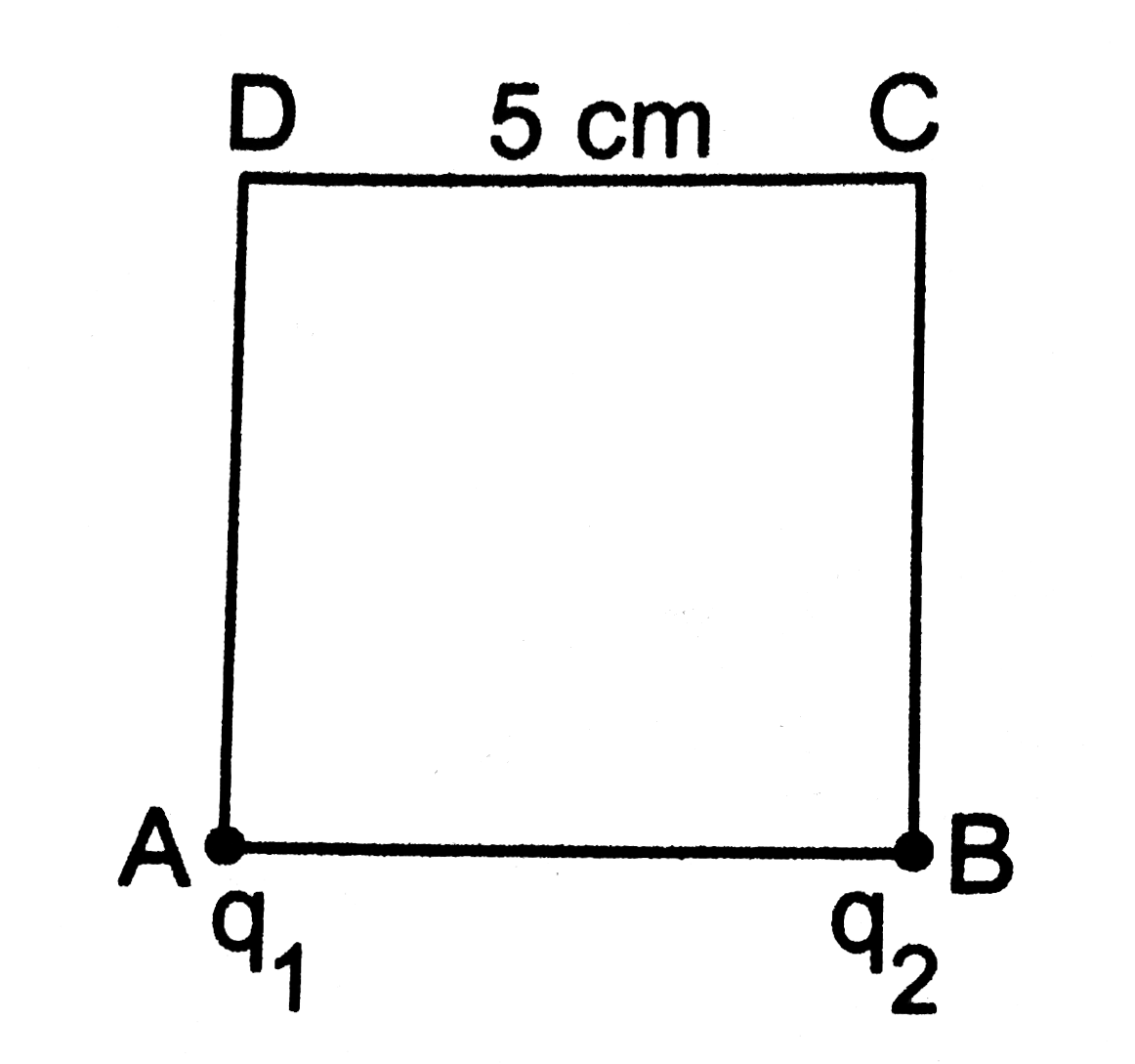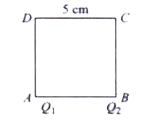Charges 5.0×−7Cand1.0×10−7C are
held fixed at the three cornners A, B, C of an equilateral
. charge at C due to the rest two.
Let's solve the problem step by step.
Step 1: Identify the Charges and Distances
Given:
- Charge at A, qA=5.0×10−7C
- Charge at B, qB=−2.5×10−7C
- Charge at C, qC=1.0×10−7C
- Side of the equilateral triangle, d=5cm=0.05m
Step 2: Calculate the Force on C due to A
The formula for the electric force between two charges is given by Coulomb's law:
F=k|q1q2|r2
Where:
- k=9×109N m2C−2
- q1=qC=1.0×10−7C
- q2=qA=5.0×10−7C
- r=d=0.05m
Substitute the values:
FCA=9×109×(1.0×10−7)×(5.0×10−7)(0.05)2
FCA=9×109×5.0×10−142.5×10−3
FCA=9×109×2×10−11
FCA=0.18N
Step 3: Calculate the Force on C due to B
Similarly, using Coulomb's law:
- q1=qC=1.0×10−7C
- q2=qB=−2.5×10−7C (magnitude only)
- r=d=0.05m
Substitute the values:
FCB=9×109×(1.0×10−7)×(2.5×10−7)(0.05)2
FCB=9×109×2.5×10−142.5×10−3
FCB=9×109×1×10−11
FCB=0.09N
Step 4: Determine the Angle Between Forces
Since the charges are at the corners of an equilateral triangle, the angle between the forces FCA and FCB is 120 degrees.
Step 5: Calculate the Resultant Force
The resultant force FR when two forces act at an angle θ is given by:
FR=√F21+F22+2F1F2cosθ
Substitute the values:
- F1=FCA=0.18N
- F2=FCB=0.09N
- θ=120∘
- cos120∘=−0.5
FR=√(0.18)2+(0.09)2+2×0.18×0.09×(−0.5)
FR=√0.0324+0.0081−0.0162
FR=√0.0243
FR≈0.156N
Final Answer
The resultant force on the charge at C due to the other two charges is approximately 0.156N.
---
Given:
- Charge at A, qA=5.0×10−7C
- Charge at B, qB=−2.5×10−7C
- Charge at C, qC=1.0×10−7C
- Side of the equilateral triangle, d=5cm=0.05m
The formula for the electric force between two charges is given by Coulomb's law:
F=k|q1q2|r2
- k=9×109N m2C−2
- q1=qC=1.0×10−7C
- q2=qA=5.0×10−7C
- r=d=0.05m
FCA=9×109×(1.0×10−7)×(5.0×10−7)(0.05)2
FCA=9×109×5.0×10−142.5×10−3
FCA=9×109×2×10−11
FCA=0.18N
Similarly, using Coulomb's law:
- q1=qC=1.0×10−7C
- q2=qB=−2.5×10−7C (magnitude only)
- r=d=0.05m
FCB=9×109×(1.0×10−7)×(2.5×10−7)(0.05)2
FCB=9×109×2.5×10−142.5×10−3
FCB=9×109×1×10−11
FCB=0.09N
Since the charges are at the corners of an equilateral triangle, the angle between the forces FCA and FCB is 120 degrees.
The resultant force FR when two forces act at an angle θ is given by:
FR=√F21+F22+2F1F2cosθ
- F1=FCA=0.18N
- F2=FCB=0.09N
- θ=120∘
- cos120∘=−0.5
FR=√0.0324+0.0081−0.0162
FR=√0.0243
FR≈0.156N
The resultant force on the charge at C due to the other two charges is approximately 0.156N.
Topper's Solved these Questions
- ELECTRIC FIELD AND POTENTIALBOOK - HC VERMACHAPTER - ELECTRIC FIELD AND POTENTIALEXERCISE - Short Answer
14 Videos
- ELECTRIC FIELD AND POTENTIALBOOK - HC VERMACHAPTER - ELECTRIC FIELD AND POTENTIALEXERCISE - Objective 1
9 Videos
- ELECTRIC FIELD AND POTENTIALBOOK - HC VERMACHAPTER - ELECTRIC FIELD AND POTENTIALEXERCISE - Exercises
75 Videos
- ELECTRIC CURRENT THROUGH GASESBOOK - HC VERMACHAPTER - ELECTRIC CURRENT THROUGH GASESEXERCISE - Exercises
23 Videos
- ELECTROMAGNETIC INDUCTIONBOOK - HC VERMACHAPTER - ELECTROMAGNETIC INDUCTIONEXERCISE - EXERCISE
9 Videos
Similar Questions
charges 2.0×10−6C and 1.0×10−6C are placed at. corners A and B of a squae of side 5.0cm as shown in. figure .how much work will be done against. the electric field in moving a charge of 1.0 xx 10^(-6) C from. C to D?.

View SolutionThree equal charges, 2.0×10−6 C each, are held fixed at the three corners of a square of side 5 cm. find the Coulomb force experienced by one of the charges due to the rest two.
View Solution
Knowledge Check
Two particles A and B having charges 8.0×10−6C and −2.0×10−6C respectively are held fixed with a. separation of 20cm. Where should a third charged. particle be placed so that it dose not experience a net electric force?.
A20 cmB40 cmC60 cmD45 cmTwo charges 4×10−8C and −6×10−8C are at points A and B respectively ,50cm apart . The electrical potential due to them is zero on the line AB at a distance from A equal to
A10cmB20cmC30cmD40cmTwo-particles A and B having charges 8×10−6Cand−2×10−6C respectively are held fixed with a separation of 20 cm. Where should a third charged particle C be placed so that it does not experience a net electric force?
A0.2mB0.8mC0.6 mD0.1 m
Charges of +5μC,+10μC and −10μC are placed in air at the corners A,B and C of an equilateral triangle ABC, having each side equal to 5 cm. Determine the resultant force on the charge at A.
View SolutionCharges 2×10−6Cand1×10−6C are placed at comers A and B of a square of side 5 cm as shown in the figure. How much work will be done against the electric field in moving a charge of 1×10−6C from C to D?

View SolutionTwo particles A and B having charges of +2.00×10−6C and of −4.00×10−6 respectively are held fixed at a separation of 20.0 cm . Locate the point(s) on the line AB where (a) the electric field is zero (b) the electric potential is zero.
View SolutionThree identical charges, each having a value 1.0×10−8C, are placed at the corners of an equilateral triangle of side 20 cm find the electric field and potential at the centre of the triangle.
View SolutionFour equal charges 2.0×10−6C each are fixed at the four corners of a squae of side 5 cm. Find the coulomba force eperienced by one of the charges due to the rest three.
View Solution
